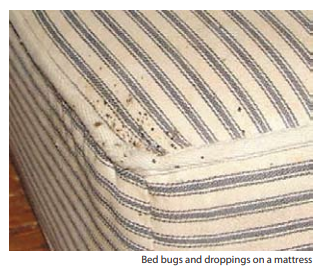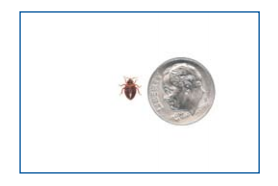Richardson, TX
Home MenuBed Bugs

What are they?
Bedbugs are small oval, non-flying insects that belong to the family Cimicidae. Three insects in this family do bite humans. Adult bedbugs can reach one quarter inch in length. Bedbugs are sometimes mistaken for ticks because of their flat bodies. Bedbugs feed by sucking blood from humans or animals. Bedbugs seek a blood meal every 4 to 5 days. They may lay up to 5 eggs a day or around 500 eggs in a lifetime and may live for up to 18 months. Adult bedbugs are usually reddish brown in color and appear more reddish after feeding on a blood meal. Nymphs are clear in color and appear bright red after feeding.

Do I have bedbugs?
Bedbugs commonly dwell in tight places such as creases of the mattress and box springs, cracks on or near the beds, behind picture frames, under wallpaper, in couches and other furniture, even in articles of clothing. They commonly accompany luggage, furniture, clothing, pillows, boxes and other objects when moved between apartments, homes and hotels. The presence of dark brown or reddish fecal stains, egg cases and shed skin may indicate a bedbug problem, though it may not confirm an active infestation. Observing the bedbugs themselves is definitive confirmation that there is a bedbug concern. You may require professional assistance from a pest control company to determine if there is an infestation in your home.
Getting rid of bedbugs
In most cases, getting rid of bedbugs will require professional treatment by a pest control expert. Some companies recommend deep scrubbings of infested areas to remove eggs, filing cracks in floors, walls and molding, and encasing mattresses in special bags. The pest control company can be of great help in determining what items are infested and should be thrown away. There are some sprays, dusts and aerosol insecticides that have been used to eliminate bedbugs. Whichever method you decide to use, it is important to know that you must perform treatment to all items at the same time. Apply treatment to areas where the bedbugs are observed and in areas that the bedbugs may crawl or hide. These areas may include carpeting, linens, closets of clothing, upholstered furniture, etc. Getting rid of bedbugs is not an easy task. Application of pesticides may occur more than once before the problem is completely eradicated. Non-chemical treatments may include a thorough vacuuming of cracks and crevices or hot water washing of clothes and other items in water at least 120 degrees Fahrenheit. Placing wet or dry items in a clothes dryer set to high heat for at least 20 minutes should kill bedbugs and their eggs. Some professional exterminators use portable devices to produce steam, heat or freezing temperatures to kill bedbugs.

Description
Color: Brown to reddish brown (after feeding).
Shape: Broadly oval & flat, looks like an apple seed and is about the same size.
Removal and Disposal
- Poor housekeeping, sanitation, etc., are not necessarily conducive to bedbug infestations, but bugs are more likely to remain undetected and efforts are more likely to fail in a cluttered home, so remove the clutter.
- Remove drawers from furniture and clean, turn furniture over to inspect and clean.
- Scrub infested surfaces with a stiff brush to remove eggs.
- After vacuuming place the vacuum bag in a plastic bag, seal tightly, and dispose of it in a container outdoors.
- When disposing of an infested item, mark as infested with bed bugs so that it will not be used by someone else, infecting their residence.
- Steam cleaning/high heat will kill bed bugs and their eggs.

Bed Bug Bites
- Bedbugs inject a tiny amount of their saliva into the skin while feeding.
- Repeated exposure to the bedbug bites may create sensitivity to the saliva resulting in an allergic response
- Bed bug bites usually appear in rows of several or more red, itchy welts, but can vary from one individual to the next.
- Though a nuisance, bedbugs are not known to transmit any diseases.
